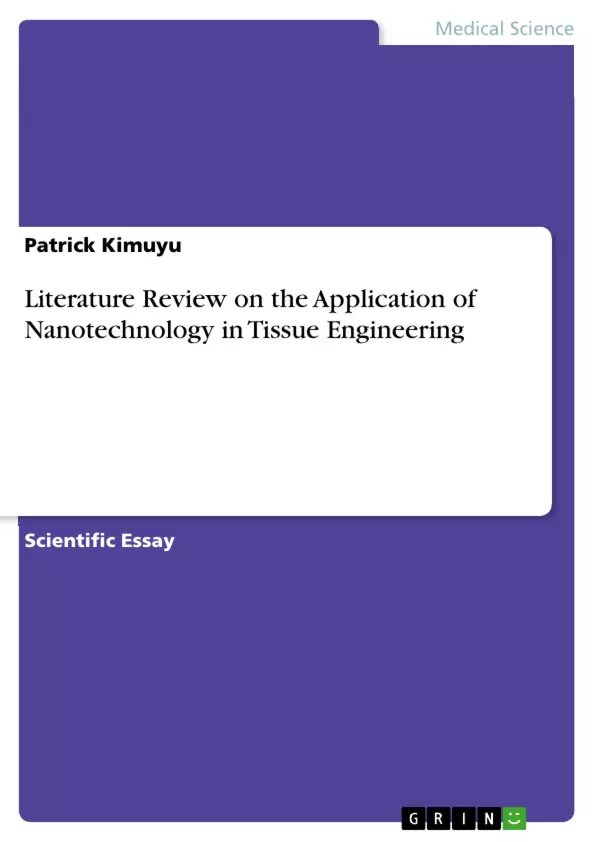Over the past few decades, the field of tissue engineering seems to have been receiving extensive attention due to its rapid growth. Nanobiotechnology has solved the existing challenge in tissue engineering using the contemporary therapies including poor vascularization of cells, low anatomical integrity of engineered cells/or tissues, immunological incompatibility with the host, and lack of functional cells. Therefore, this paper provides a systematic review of literature on the application of nanotechnology in tissue engineering.
Inhaltsverzeichnis (Table of Contents)
- Introduction
- Literature Review
- Nanomaterials for Tissue Engineering
- Self-assembled nanomaterials
- Electrospun nanofibers
- Nanotextured substrates
- Benefits of Using Nanomaterials for Tissue Engineering
- Applications of Nanotechnology in Tissue Engineering
- Neural cells tissue engineering
- Vascular cells tissue engineering
- Stem cells tissue engineering
- Cartilage cells tissue engineering
- Bone cells tissue engineering
- Hepatic cells tissue engineering
- Gene engineering
- Nanomaterials for Tissue Engineering
- Conclusion
- Future challenges and solutions
- References
Zielsetzung und Themenschwerpunkte (Objectives and Key Themes)
This paper aims to provide a comprehensive review of the literature on the application of nanotechnology in tissue engineering, focusing on the use of nanomaterials to facilitate tissue regeneration. The paper explores the benefits and applications of nanotechnology in tissue engineering, highlighting its potential to address challenges related to vascularization, anatomical integrity, immunological compatibility, and functional cell development.
- The role of nanomaterials in tissue engineering and their ability to mimic native tissues.
- Different types of nanomaterials used in tissue engineering, including self-assembled nanomaterials, electrospun nanofibers, and nanotextured substrates.
- The benefits of using nanomaterials for tissue engineering, including improved cell behavior, enhanced vascularization, and increased cell adhesion.
- The application of nanotechnology in various areas of tissue engineering, including neural cells, vascular cells, stem cells, cartilage cells, bone cells, hepatic cells, and gene engineering.
- The potential of nanotechnology to revolutionize tissue engineering and provide new treatment options for various medical conditions.
Zusammenfassung der Kapitel (Chapter Summaries)
The introduction of this paper highlights the growing importance of tissue engineering and its potential to address the challenges associated with tissue damage and regeneration. The paper emphasizes the role of nanotechnology in tissue engineering and its ability to overcome limitations of traditional therapies.
The literature review section delves into the use of various nanomaterials in tissue engineering, including self-assembled nanomaterials, electrospun nanofibers, and nanotextured substrates. The paper explores the mechanisms behind the development of these nanomaterials, focusing on their biocompatibility and ability to promote tissue regeneration.
The paper then outlines the benefits of using nanomaterials in tissue engineering, emphasizing their ability to create a favorable extracellular microenvironment, improve cell behavior, and enhance vascularization. The paper also discusses the application of nanotechnology in various areas of tissue engineering, including neural cells, vascular cells, stem cells, cartilage cells, bone cells, hepatic cells, and gene engineering.
Schlüsselwörter (Keywords)
The primary keywords and focus topics of this paper are: nanobiotechnology, tissue engineering, nanomaterials, self-assembled nanomaterials, electrospun nanofibers, nanotextured substrates, neural cells, vascular cells, stem cells, cartilage cells, bone cells, hepatic cells, gene engineering, regenerative medicine, biocompatibility, biomimicry, vascularization, cell adhesion, cell differentiation, tissue regeneration.
- Quote paper
- Patrick Kimuyu (Author), 2017, Literature Review on the Application of Nanotechnology in Tissue Engineering, Munich, GRIN Verlag, https://www.grin.com/document/378825



